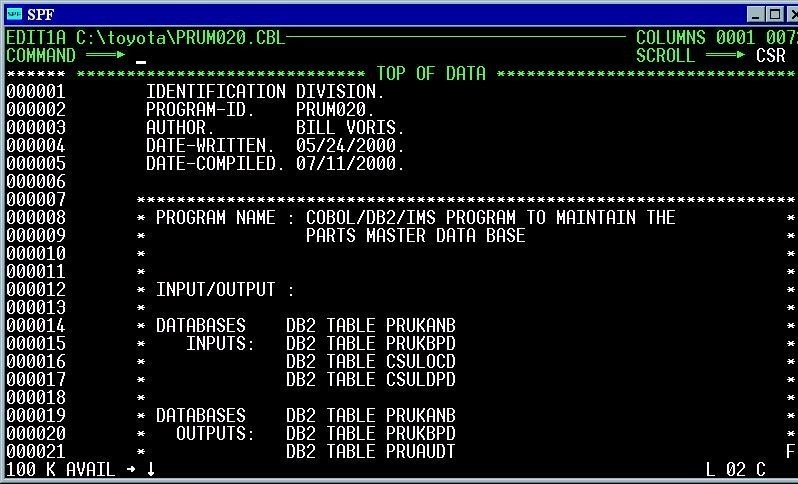
The computer industry, especially IBM, is promoting the concept of analytics. Analytics is a new word, but not a new concept. Being able to use existing data to predict future outcomes has significant advantages. Computer analytics has revolutionized inventory management in the auto industry. It's applicability to other aspects and types of manufacturing processes are at the very beginnings. The value to be extracted by the application of analytics finds no greater value than in JIT (Just-In-Time) manufacturing. To date Just-In-Time manufacturing is the most successful application of analytics. Today the nomenclature JIT manufacturing has been replaced with Lean Manufacturing.
Over the years many corporations have tried to apply analytics to manufacturing processes. In the late 1970's the Hobart Corporation attempted to develop a manufacturing system with Materials Requirements Planning. It was highly advanced for its time. It was one of the very first attempts at a multi-tier distributed processing system, pre-dating client-server by more than two decades. The top tier utilized an IBM Mainframe and the servers were IBM 3790 and 8100 minicomputers. In those days mini-computers had to be programmed in complex and counter-intuitive assembler languages. The 3790 and 8100's were no different in that they had to be programmed in a hybrid assembler language called DPCX and DPPX. Hobart hired outside consultants to develop the software for these mini-computers. However once developed and the contract budget was exhausted the consultants left. The reductions in inventory costs that the MRP system was supposed to produce were not occurring.
Hobart then decided to hire a permanent employee to see if he could figure out this MRP system and make it work. They sent this employee to IBM in Chicago to learn the DPCX and DPPX assembler code. At that time Hobart had three plants, Plant 1, Plant 2 and Plant 27 (retro named the Sunshade). The Sunshade was chosen as the beta test for this custom developed software. The employee spent several hours in the plant drawing out all the individuals involved in the process of MRP. Some thought that the computer was going to take away their job, others were unsure how to use this software. Within a month of this employee gaining access to this software and spending time with the employees in the plant the system started to work. A major meeting was called by the senior vice president of Hobart. In the first month of operation the inventory savings for the smallest of Hobart's plants was over $20,000. Each successive month saw even greater reductions in inventory costs. Overjoyed by this success Hobart asked this employee to install this software and get it working at Plant 1 and Plant 2. Working closely with IBM, this employee managed to install and get this MRP software functioning. This MRP system was a precursor to JIT Manufacturing.
Just-In-Time manufacturing was attempted many times over the years. However it was Toyota and its Toyota Production System that finally was able to make Just-In-Time manufacturing work. The value of JIT manufacturing has revolutionized production at Toyota. One might wonder who was the computer consultant who programmed the Parts Master Data Base program for Toyota to make JIT manufacturing a reality, or who was the employee at Hobart who made MRP work?
Over the years many corporations have tried to apply analytics to manufacturing processes. In the late 1970's the Hobart Corporation attempted to develop a manufacturing system with Materials Requirements Planning. It was highly advanced for its time. It was one of the very first attempts at a multi-tier distributed processing system, pre-dating client-server by more than two decades. The top tier utilized an IBM Mainframe and the servers were IBM 3790 and 8100 minicomputers. In those days mini-computers had to be programmed in complex and counter-intuitive assembler languages. The 3790 and 8100's were no different in that they had to be programmed in a hybrid assembler language called DPCX and DPPX. Hobart hired outside consultants to develop the software for these mini-computers. However once developed and the contract budget was exhausted the consultants left. The reductions in inventory costs that the MRP system was supposed to produce were not occurring.
Hobart then decided to hire a permanent employee to see if he could figure out this MRP system and make it work. They sent this employee to IBM in Chicago to learn the DPCX and DPPX assembler code. At that time Hobart had three plants, Plant 1, Plant 2 and Plant 27 (retro named the Sunshade). The Sunshade was chosen as the beta test for this custom developed software. The employee spent several hours in the plant drawing out all the individuals involved in the process of MRP. Some thought that the computer was going to take away their job, others were unsure how to use this software. Within a month of this employee gaining access to this software and spending time with the employees in the plant the system started to work. A major meeting was called by the senior vice president of Hobart. In the first month of operation the inventory savings for the smallest of Hobart's plants was over $20,000. Each successive month saw even greater reductions in inventory costs. Overjoyed by this success Hobart asked this employee to install this software and get it working at Plant 1 and Plant 2. Working closely with IBM, this employee managed to install and get this MRP software functioning. This MRP system was a precursor to JIT Manufacturing.
Just-In-Time manufacturing was attempted many times over the years. However it was Toyota and its Toyota Production System that finally was able to make Just-In-Time manufacturing work. The value of JIT manufacturing has revolutionized production at Toyota. One might wonder who was the computer consultant who programmed the Parts Master Data Base program for Toyota to make JIT manufacturing a reality, or who was the employee at Hobart who made MRP work?




Double click here to edit this text.
Double click here to edit this text.